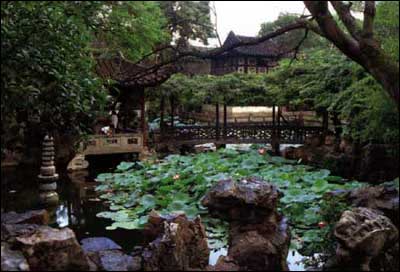Ancient Gardens in Suzhou
Suzhou is located in the south of the Yangtze River Delta and borders Taihu Lake to the west and Shanghai to the east. It is an oriental water city as well as a famous historical and cultural center with a history going back 2,500 years.
 It is also a source of the unique Taihu rocks and over a long period many officials built gardens here. In the Ming and Qing dynasties, there were some 200 gardens and the city was renowned both in China and abroad for its small but elegant private gardens. They represent the quintessence of the gardens found in the southern area of Jiangsu Province and demonstrate the varied styles of the Song Dynasty (960-1279), Yuan Dynasty (1206-1368), Ming Dynasty (1368-1644) and Qing Dynasty (1616-1911). The Blue-Waves Pavilion Garden, the Lion Grove Garden, the Humble Administrator′s Garden and the Linger-Here Garden are the most important ones in the city and illustrate architectural styles of the Song, Yuan, Ming and Qing dynasties.
It is also a source of the unique Taihu rocks and over a long period many officials built gardens here. In the Ming and Qing dynasties, there were some 200 gardens and the city was renowned both in China and abroad for its small but elegant private gardens. They represent the quintessence of the gardens found in the southern area of Jiangsu Province and demonstrate the varied styles of the Song Dynasty (960-1279), Yuan Dynasty (1206-1368), Ming Dynasty (1368-1644) and Qing Dynasty (1616-1911). The Blue-Waves Pavilion Garden, the Lion Grove Garden, the Humble Administrator′s Garden and the Linger-Here Garden are the most important ones in the city and illustrate architectural styles of the Song, Yuan, Ming and Qing dynasties.
The Blue-Waves Pavilion Garden is the oldest and was a villa in the old days. Built in a unique style the garden makes use of and combines landscapes outside as well as inside the garden. the garden itself is composed of rocks, green bamboo groves and hills. Bright Path Hall is the largest building in the garden. The west wall of the hall is carved with more than 500 images of celebrities who have figured in Suzhou′s history.
Lion-Grove Garden is on the Yuanlin Road in the city itself. The garden, built in the Yuan Dynasty, is famous for its rockeries, most of which look like lions, hence the name. It is small but well arranged and to the southeast there are hills while in the northwest there is water. Around the garden there is a walkway that follows the contours of the land and there are number of buildings that are in perfect harmony with the scenery including Yanyu Hall, Sleeping-Clouds Chamber and Seek-Plum-Blossoms Tower.
The Humble Administrator′s Garden on Northeast Street in the city is the largest of its kind in the area. It is one of China′s four major gardens and a masterpiece of the private classic garden. About three-fifths of the garden is a water area and most of the major buildings were built beside water; they are simple and elegant. There are a dozen pavilions built in different styles and the garden is divided into three parts-east, middle and west. The middle part features the essential qualities of the garden.
The Linger-Here Garden was first built in the Ming Dynasty. It is famous for its composition and variety. Groups of buildings are used ingeniously to divide and compose the space into ever-changing garden scenes. The garden is divided into four parts-central, eastern, western and northern. The central part is characterized by hills and water and is quiet and peaceful. The eastern part features double-eaved buildings. The northern part has rural scenery and the western part natural scenery. The four parts are linked together by a winding path. The central and eastern parts are the most distinctive.
It is included in the UNESCO world heritage list in 1997.
Source: http://old.cnta.gov.cn